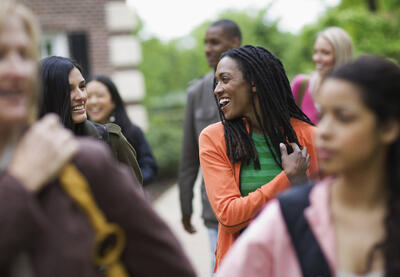How do we teach compassion? It requires action.
“Secret Agents of Kindness” tells the story of how educator Ferial Pearson’s program of active kindness inspired Erin Mangahis, another teacher, to take on this work. Each week, Mangahis’ high school students become spies, working in secret to seek out and offer acts of kindness at their school. After reading this story, I decided that my own students at Ohio Northern University could benefit from practicing active kindness as well.
We began by discussing what it means to be kind. When is the last time you considered this?
Most schools discuss the value of kindness in elementary school, but at some point, the talk stops. Why? As we advocate for social justice, we need to understand that kindness is a point of connection—a first step that can further new awareness and understanding of different ideas, cultures and people. Kindness can help us build connections to those whose experiences are different from our own. It is a first step toward equity.
In my class, students drew on the work of the Dali Lama—who also inspired Pearson—to consider the idea of kindness. He states, “Compassion is not just being kind to your friend. That involves attachment because it is based on expectation. Compassion is when you do something good without any expectations—based on realizing that ‘the other person is also just like me.’”
We generated kindness assignments. We considered how teachers of any grade—not just elementary—could encourage students to be kind. How would a classroom culture change if students were regularly, anonymously sharing positive notes with classmates? How could classroom agreements change if we regularly asked students to act on kindness, without any expectation of thanks or even recognition? What assignments could we do as a class? What could we learn? These types of assignments are initially about awareness and a way of thinking about identity. From practicing kindness as a means of action, students’ perceptions of others can change.
The first assignment my class chose seemed simple: We would each share an anonymous, positive note with someone—kindness with no expectation of a response. I quickly learned, however, that active kindness requires more work than I’d expected. I wrote on a card, “I see the good work you do” and arranged for it to be delivered to a student. I chose this student because I knew she was struggling but working hard at school. First assignment: Done! I thought. Not exactly. “This person probably doesn’t even know me,” I overheard her say. “It says nothing about me.”
It is not enough just to say, “Good job.” Active kindness is about more than just being nice. It’s about trying to understand what others need from you and doing your best to provide it. It’s about really seeing the people around you.
This is the first step toward social justice. Instead of simply doing what we think best, we envision the effects of our actions on others. We learn what others need. This requires collectively talking about these ideas and listening. As a group, we not only acted on our kindness; we discussed how our actions could improve.
As one post-graduate student explained, “Kindness is behaving like a human.”
As for the results at our university, the halls throughout our building now hold notes about kindness. The tone in the hallways and classrooms is changing. Professors and students talk about how they receive kind actions and what a kind action really means. Many instructors are making kindness part of the curriculum. We talk about it at meetings and in classes, and we’ve heard from staff that students are more compassionate. The actions reverberate.
As for my own class, we are advising an anti-bullying middle school club in a neighborhood that has seen its share of violence. They are building Secret Kindness Agents into their program, and fifth-graders are in charge.
When we as teachers plan for kindness, let us not limit our plan to a single event or a single age group. Instead, let’s watch what happens with our students and our classrooms when we repeat the importance of kindness. Compassion becomes contagious.
Imagine the changes in your school when kindness becomes part of your policy or your curriculum.
Here’s how to start:
- Instead of simply asking students to be kind, create a culture around the action. Meet with them weekly and create a conversation about the difference between being kind and making kindness an action.
- Model the process so students can see that it is not just an assignment; it is a choice that you make as well.
- Listen to students’ ideas on how to expand the program.
- Work with your students on “next steps.” What more can you do in your class, school and community?
Here’s what students have to say:
“This has changed my mindset into a more positive one, focused on alleviating stress or difficulties or uplifting others than thinking about myself. ... The meetings held me accountable for my actions of kindness. Even when I was tempted to slack off for a week, I was inspired by what others did and how they were affected.” —Rachel Liebrecht, Ohio Northern University senior
“From being in the program, my opinion of kindness has shifted. I once thought of kindness as doing something to help others. After being a member, kindness involves ... living a selfless life while constantly expressing love for others through actions.” —Madison Broering, Ohio Northern University sophomore
Cordi is an assistant professor at Ohio Northern University and a member of the Teaching Tolerance Advisory Board.
